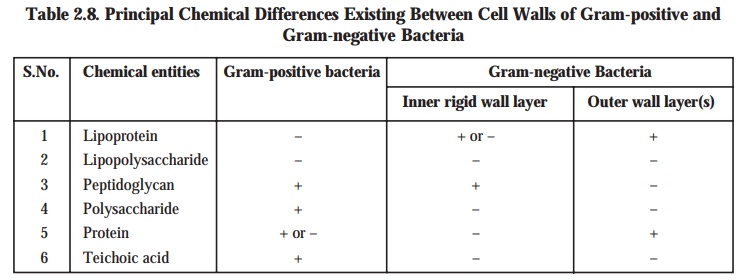Gram-Positive and Gram-Negative Bacteria
| Home | | Pharmaceutical Microbiology | | Pharmaceutical Microbiology |Chapter: Pharmaceutical Microbiology : Structure and Function of Bacterial Cells
The various characteristic features of Gram-positive and Gram-negative bacteria shall be dis-cussed at length in this particular section.
Gram-Positive and Gram-Negative Bacteria
The various characteristic features of Gram-positive and Gram-negative bacteria shall be dis-cussed at length in this particular section.
For Gram-negative bacteria. There are two distinct layers that have been duly recognized in the cell envelopes of Gram-negative bacteria, namely :
(a) An uniform inner layer approximately 2–3 mm wide, and
(b) A thicker outer layer nearly 8–10 nm wide.
Importantly, the peptidoglycan is prominently confined to the inner layer ; whereas, the outer layer (membrane) essentially comprises of proteins, lipoproteins, and lipopolysaccharides.
The principal chemical differences that predominently occur between the cell walls of Gram-positive bacteria and the inner rigid wall layer and outer wall layer(s) of Gram-negative bacteria have been duly summarized in Table 2.8 given below :
Table 2.8. Principal Chemical Differences Existing Between Cell Walls of Gram-positive and Gram-negative Bacteria

Cardinal characteristic features of component variants in Gram +ve and Gram –ve micro-organisms : The various important characteristic features of component variants in Gram +ve and Gram –ve microbes are as stated under :
(1) Peptidoglycans belonging to the Gram –ve microorganisms exhibits a rather low extent of cross linkages within the glycan strands.
(2) Outer-membrane. The fine structure of the outer membrane, very much akin to cell mem-brane, essentially comprises of a lipid bilayer wherein both phospholipids and lipopolysaccharides are definitely present. Besides, the lipopolysaccharide generates the major component of the outer membrane, and represents an extremely complex molecule varying in chemical composition within/between the Gram –ve bacteria.
(3) Outer surface. The peptidoglycan of the wall has particular kinds of lipoproteins residing on its outer surface, that are strategically linked by peptide bonds to certain diaminopimelic acid residues present in the peptidoglycan.
(4) Lipoproteins evidently serve as a sort of bridge right from the peptidoglycan upto the outer-wall-layer.
(5) The total number of proteins definitely present, unlike in the inner membrane, are quite a few in number (approx. 10) ; and, therefore, these are markedly distinct from those invari-ably found in the inner membrane.
Typical Example : It has been observed that the lipopolysaccharides belonging to either E. coli or Salmonella sp. necessarily comprise of subunits, and each subunit consists of three vital compo-nents, namely : (a) a lipid ; (b) core region ; and (c) O-side chain respectively, as given in Fig. 2.13.

Explanations : The proper explanations for the various transformations occurring in Figure : 2.13 are as given below :
(i) The various subunits in lipopolysaccharide are duly linked via pyrophosphates with the ‘lipid zone’.
(ii) The ‘lipid zone’ comprises of a phosphorylated glucosamine disaccharide esterified adequately with long chain fatty acids.
(iii) The ‘core region’ comprises of a short-chain of carbohydrates, and the O-side chain consists of different carbohydrates and is much longer in comparison to the R-core region.
(iv) Lipopolysaccharides represent the major antigenic determinants, and also the receptors for the active adsorption of several bacteriophages.
Comparative Activities of Gram-negative and Gram-positive Bacteria
The various glaring comparative activities of both Gram-negative and Gram-positive bacteria are enumerated below :
(1) It has been duly demonstrated that the outer membrane of Gram-negative bacteria promi-nently behaves as a solid barrier to the smooth passage of certain critical substances, for instance : antibiotics, bile salts*, and dyes into the cell. Hence, the Gram-negative organisms are comparatively much less sensitive to these substances than the Gram-positive ones.
(2) Adequate treatment of Gram-negative bacteria with an appropriate chelating agent, such as : ethylenediaminetetra acetic acid (EDTA), that eventually affords the release of a substantial amount of lipopolysaccharides renders ultimately the cells more sensitive to the drugs and chemical entities. Thus, the presence of lipopolysaccharide on the surface of the cell also helps the bacteria to become resistant to the phagocytes** of the host.
(3) The resistance acquired in (2) above is almost lost only if the host enables to synthesize the antibodies that are particularly directed against the O-side chain (Figure 2.13). There exists a vast diversification in the specific structure of the O-side chain ; and, therefore, gives rise to the somatic*** antigenic specificity very much within the natural bacterial populations. Evidently, the ensuing antigenic diversity exhibits a distinct selective advantage specifi-cally for a pathogenic bacterial species, because the animal host is not in a position to pos-sess higher antibody levels strategically directed against a relatively large number of varie-ties of O-side chains.
(4) In general, the prevailing lipids are invariably found to be phosphatidylethanolamine, and apparently to a much smaller extent phosphatidylserine and phosphatidylcholine, present duly in Gram-negative and Gram-positive bacteria.

